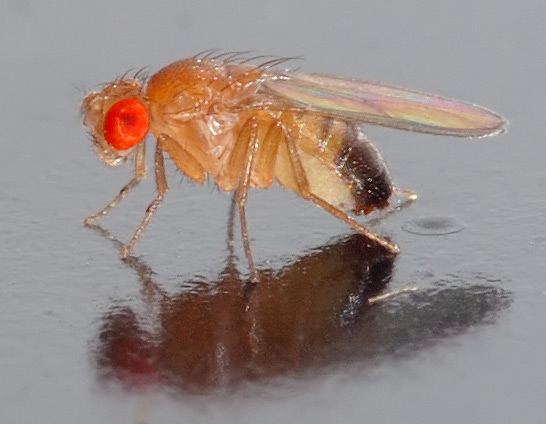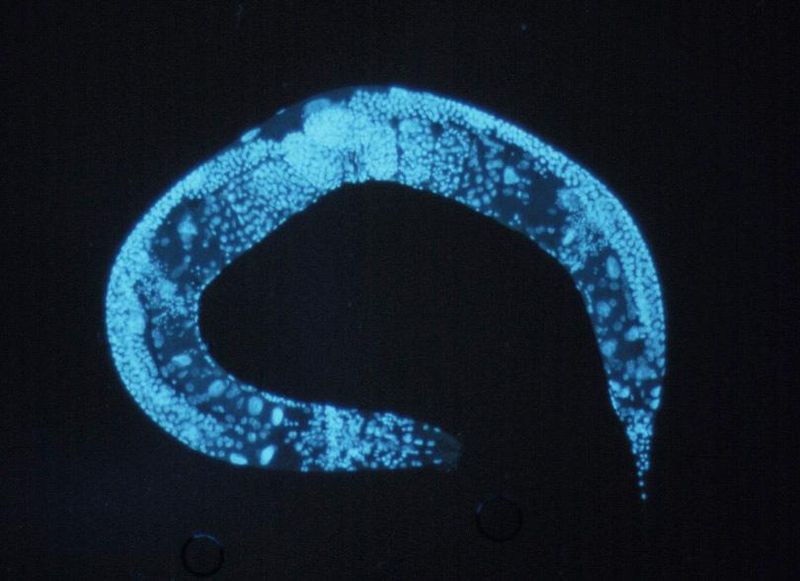Damage and Fidelity: The Role of the Female Germline in mtDNA Inheritance
By Claire Asher, on 11 November 2013
Billions of years ago, one single-celled organism engulfed another, beginning a symbiotic interaction that would change live on Earth forever. The mitochondria are what remains of this symbiotic event, and are responsible for producing energy in all eukaryotic cells. Derived from a free-living organism, they carry their own genes, but these genes are at risk of damage by a natural by-product of energy production – free radicals. Mitochondrial DNA in most cells are exposed to these reactive oxygen species and may be damaged over time, resulting in some diseases of age. However, if damage occurs to the mitochondrial genes in egg and sperm cells, this damage would be passed on to the next generation. Despite this, aging is not heritable, and very few mitochondrial mutations are passed from one generation to the next. Researchers in GEE have been investigating the mechanism responsible for this apparent paradox – mitochondrial inactivation – and have discovered that this mechanism is extremely widespread in the animal kingdom.
The mitochondria are the powerhouses of the cell, generating energy through oxidative phosphorylation down an electron transport chain. The electron transport chain occurs across the mitochondrial membrane, and was a key innovation during the evolution of multicellular life. Mitochondria originated as free-living single celled organisms that were engulfed inside another cell and subsequently formed a cooperative partnership that allowed cells to produce energy more efficiently. Because of their symbiotic origin, mitochondria brought an entire genome with them, and although this has been wittled down to only a small number of genes, some genes still reside inside the mitochondria. This is a big problem, however, because in the process of producing energy, mitochondria also produce harmful reactive oxygen species (ROS), also known as free radicals. These can cause mutations in DNA, and the mitochondrial genes are therefore at great risk because of their proximity to the site of ROS production. Mutations in mitochondrial DNA are thought to be a key cause of age-related diseases.

The Electron Transport Chain
Image by Rozzychan, creative commons.
Mutations in DNA (mitochondrial or nuclear) in most cells in the body can be harmful to the health of the individual, but will have no influence on the next generation. The genes which we pass onto the next generation are separated off during early development into special ‘germ line’ cells which form sperm and eggs. Great care is taken to minimise the risk of mutation to these genes – genes in germline cells act as a blue print for the next generation. This is essentially why aging is not heritable, and it is a system that works pretty well.

Sperm Cells
Image by be_sperm
However, sperm and egg cells need mitochondria to produce energy, and so mitochondrial genes in our germ cells may still be at risk of mutation. If the free radicals generated in germ-line mitochondria harm mitochondrial DNA, these damages would be passed on to the next generation! Research in GEE has uncovered a rather elegant solution to this problem – those mitochondria that will be passed to the next generation are maintained in an inactive state. It’s a bit like buying two toasters and keeping one in a cupboard, unused, to provide a template from which to build a new toaster when the old one breaks.
Mitochondria are only inherited through the maternal line – every mitochondria in your body came from your mother, and this is true for most animal species. The mitochondria in sperm are generally discarded at some point prior to fertilisation. So, in order to preserve the fidelity of mitochondrial DNA passed on to the next generation, we only need to ‘switch-off’ mitochondria in egg cells. This is great, since sperm really need their mitochondria to provide energy for all that swimming!

Egg Cell
Previous research by John Allen and colleagues in GEE indicated that mitochondria in egg cells of the moon jellyfish (Aurelia aurita) are inactive compared to mitochondria in sperm and somatic tissues. Recently, GEE’s Prof John Allen, along with Wilson de Paula (Queen Mary University of London) and colleagues have investigated this phenomenon further and discovered that this system of mitochondrial inactivation is widespread across the animal kingdom. Using qPCR, a technique for measuring and comparing expression patterns of specific genes, they found that in both fruit flies (Drosophila melanogaster) and zebrafish (Danio rerio) expression of three key respiratory genes (nad1, cob & cox1) is much lower in mitochondria in oocytes (egg cells) than in sperm and active muscle tissue. Expression levels were 15-fold lower in eggs, whereas sperm and muscle showed similar levels of expression. They also found that membrane electrical potential, a measure of the activity of the electron transport chain, was reduced in oocytes compared to both sperm and the surrounding tissue. Further, ROS production was 50- and 100-fold lower in the eggs of fruit flies and zebrafish respectively. Finally, they confirmed that oocyte mitochodria in both species exhibit a simpler structure, indicative of reduced activity. So, it seems that in both fish and flies, the mitochondria in egg cells represent little more than a blueprint, ready to be passed on to the next generation error-free. By deactivating ovarian mitochondria, the fidelity of information is ensured across generations, and aging is not heritable.



Wilson de Paula and Prof John Allen have now identified a similar pattern of mitochondrial inactivation in species across the animal kingdom, including jellyfish, fruitflies and zebrafish. Early in multicellular evolution, animals branched into two key groups distinguished by differing patterns of embryonic development; protostomes (including arthropods, molluscs and nematodes) develop their mouth first, whereas deuterostomes (including vertebrates, tunicates and starfish) develop their anus first. This seemingly small difference represents a fundamental divide in the animal kingdom. This study therefore demonstrates that mitochondrial inactivation occurs in both of these key branches. Previous work by de Paula and Allen has shown a similar pattern in jellyfish, members of the phylum Cnidaria which pre-date the great protostome-deuterstome divide. Together, this work suggests that mitochondrial inactivation, as a mechanism to ensure fidelity of mitochondrial DNA transmission across generations, is likely to have emerged early in the evolution of multicellular life on Earth.
Ensuring the faithful transmission of genes to the next generation is a key problem for all life on Earth. Although the mitochondrial symbiosis event which marked the emergence of eukaryotic life was a major breakthrough in efficient cellular energy production, it brought problems of its own. Mitochondria must carry a few genes in order to maximise responsivness to cellular demands, but these genes are at risk of damage from a natural by-product of energy production – free radicals. A system of mitochondrial inactivation in female germ cells (eggs) may serve to resolve this conundrum, and seems to be shared across all animal life.
Original Article:


This research was made possible by funding from the Natural Environment Research Council (NERC), and the The Leverhulme Trust
 Close
Close




 This research was made possible by funding from the
This research was made possible by funding from the